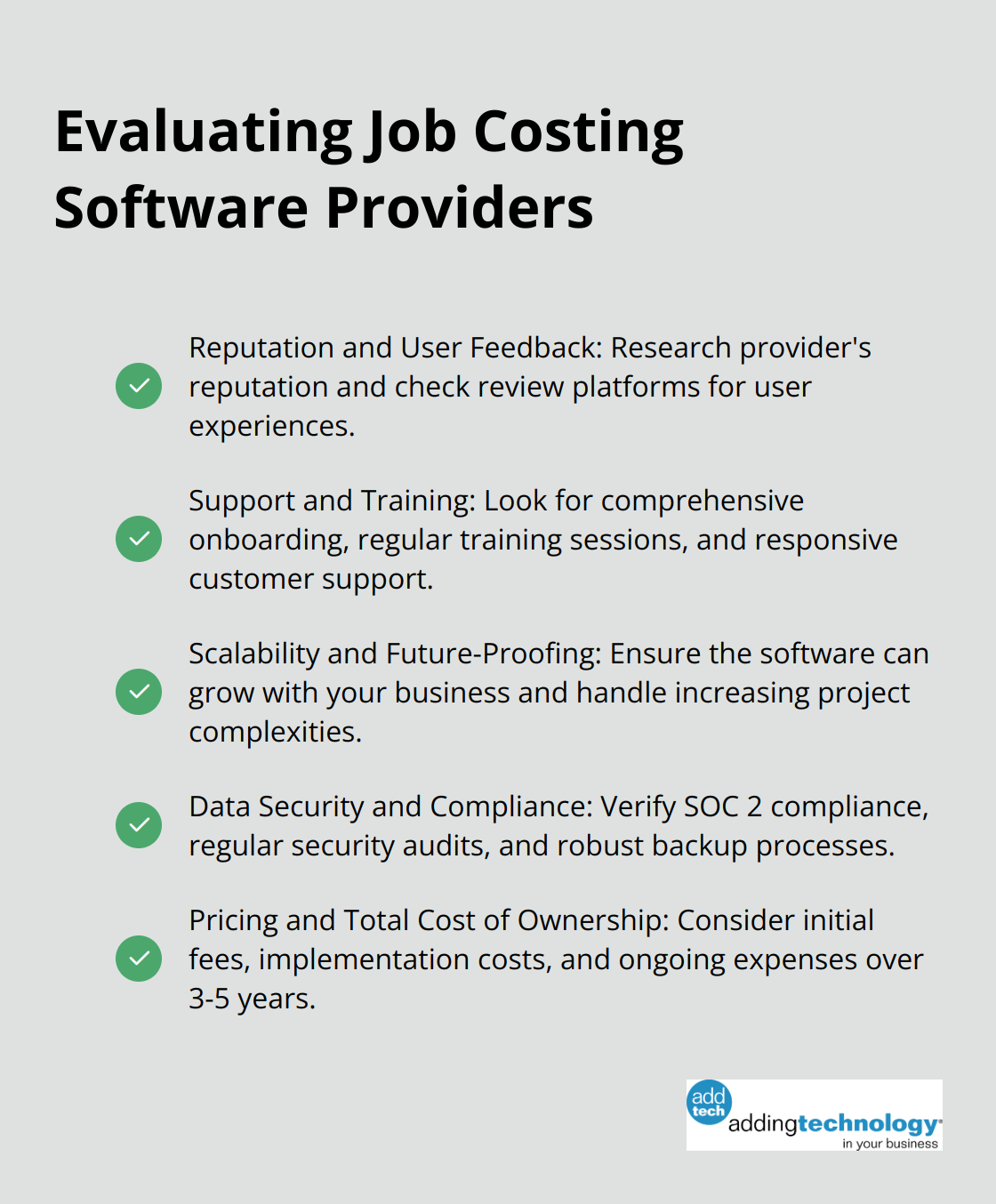
Choosing the right job costing software for the construction industry can make or break your project’s financial success. At Adding Technology, we’ve seen firsthand how proper cost tracking tools boost efficiency and profitability.
This guide will walk you through the essential features to look for, how to evaluate software providers, and strategies for successful implementation. We’ll help you navigate the complex world of construction job costing software to find the perfect fit for your business.
Real-time project tracking stands as a cornerstone feature in job costing software. It enables firms to monitor spending in real time, adjust budgets dynamically, and eliminate waste before it impacts profitability. This capability empowers quick decision-making and course corrections.
Your job costing software must integrate smoothly with your existing accounting systems. This integration eliminates double data entry, reduces errors, and provides a comprehensive view of your financial landscape.
For example, integration with QuickBooks (a common requirement for many construction firms) should be a priority. Ensure the software you select can sync data bidirectionally with your preferred accounting platform.
Construction happens in the field, not just in the office. Mobile accessibility proves essential for capturing costs and updates on-site. Select software with robust mobile apps that allow project managers and field workers to input data, approve time sheets, and view reports from their smartphones or tablets.
Every construction business has unique cost tracking needs. Your job costing software should offer customizable cost codes and categories that align with your specific projects and accounting structure. This flexibility ensures that you can track costs in a way that makes sense for your business and provides meaningful insights.
Effective management of subcontractors and vendors proves crucial for keeping projects on budget. Look for software that helps you track subcontractor payments, manage change orders, and monitor vendor performance. These features can help prevent costly disputes and ensure smooth project execution.
The right job costing software should feel tailored to your specific needs. It should simplify complex processes, provide clear insights, and ultimately contribute to your bottom line. As you evaluate options, keep these key features in mind and prioritize the ones that align most closely with your business goals.

Now that we’ve covered the essential features to look for in job costing software, let’s turn our attention to how you can effectively evaluate software providers to ensure you’re making the best choice for your construction business.
When you select job costing software for your construction business, the provider behind the software plays a crucial role in your long-term success. Here’s what you need to consider:
Research the provider’s reputation in the construction industry. Look for case studies specific to businesses similar to yours. If you’re a mid-sized commercial contractor, seek out success stories from companies of similar scale and focus.
Check review platforms like Capterra and G2 for user feedback. Pay attention to comments about customer support, ease of use, and how well the software handles real-world construction scenarios.
The level of support and training offered can significantly impact your software implementation. Look for providers that offer:
Procore, for example, is known for its comprehensive support site with step-by-step tutorials, FAQs, user guides, and learning paths, which can smooth the transition process.
Your chosen software should grow with your business. Ask potential providers about:
Cloud-based solutions often offer better scalability. They can easily accommodate growing data needs and user bases without requiring significant hardware investments.
In construction, project data is sensitive and valuable. Ensure your provider takes data security seriously. Look for:
While upfront costs are important, consider the total cost of ownership over 3-5 years. This includes:
The cheapest option isn’t always the most cost-effective in the long run. A more expensive solution that saves time and improves accuracy could provide a better return on investment.
When you evaluate providers, ask for a detailed demo tailored to your specific needs. This hands-on experience can reveal how well the software aligns with your workflows and whether it truly delivers on its promises.

Now that you understand how to evaluate software providers, let’s explore strategies for successful implementation and adoption of your chosen job costing software.
Before implementation, analyze your current job costing processes. Conduct a thorough process audit to identify inefficiencies and areas where manual work slows you down. This audit will help you prioritize which features of your new software to implement first and create an up-to-date audit trail of all receipts, income, and expenses.
If you find that time tracking is a major bottleneck, set up and train your team on the software’s time tracking module first. This targeted approach can lead to quick wins and boost team buy-in.
Implement the software in manageable phases. A phased implementation plan should include essential aspects of accurate job costing that every construction professional should master. A typical phased approach might look like this:
This approach allows your team to adapt gradually and prevents overwhelming them with too much change at once.

Plan for ongoing training sessions, both group and individual, to ensure your team becomes comfortable with the new software. Appoint “software champions” within each department who can provide peer-to-peer support.
Data migration can challenge implementation. Start by cleaning your existing data – remove duplicates, standardize formats, and archive old or irrelevant information.
Migrate only the most recent and relevant data initially (e.g., the last two years of financial data and only active projects). This approach can speed up the migration process and reduce the risk of errors.
Set clear Key Performance Indicators (KPIs) to measure the success of your implementation. These might include:
Review these KPIs regularly and make adjustments to your processes or provide additional training as needed.
Job costing software for the construction industry revolutionizes project financial management. It provides real-time visibility into costs, enables data-driven decisions, and identifies potential issues before they escalate. The right solution, properly implemented, can significantly boost your company’s profitability and growth.
We at Adding Technology specialize in streamlining financial processes for construction firms. Our expertise can help you navigate the complexities of implementing job costing software (ensuring your financial foundation remains solid). We focus on optimizing your job costing processes so you can concentrate on building great projects.
Take a proactive approach to evaluating and implementing job costing software for your construction business. The impact on project profitability and efficiency cannot be overstated. Start your journey towards better financial control and project success today.









At adding technology, we know you want to focus on what you do best as a contractor. In order to do that, you need a proactive back office crew who has financial expertise in your industry.
The problem is that managing and understanding key financial compliance details for your business is a distraction when you want to spend your time focused on building your business (and our collective future).
We understand that there is an art to what contractors do, and financial worries can disrupt the creative process and quality of work. We know that many contractors struggle with messy books, lack of realtime financial visibility, and the stress of compliance issues. These challenges can lead to frustration, overwhelm, and fear that distracts from their core business.
That's where we come in. We're not just accountants; we're part of your crew. We renovate your books, implement cutting-edge technology, and provide you with the real-time job costing and financial insights you need to make informed decisions. Our services are designed to give you peace of mind, allowing you to focus on what you do best - creating and building.
Here’s how we do it:
Schedule a conversation today, and in the meantime, download the Contractor’s Blueprint for Financial Success: A Step by-Step Guide to Maximizing Profits in Construction.” So you can stop worrying about accounting, technology, and compliance details and be free to hammer out success in the field.